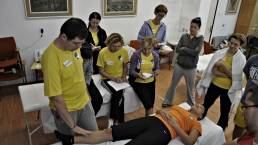Myofascial release technique
"Myo" refers to muscle."Fascia" refers to an elastic sheath of connective tissue.
Muscles and fascia are one, they "work together" and only in their harmony does the body function in a proper and healthy way. As a result of any kind of trauma in the body, fascia becomes inelastic and, as a result, this restriction tightens the muscles, causing tension, pain, stress and limited movement.
The creator of this advanced rehabilitation technique is Dr. John F. Barnes. In the last decade, this technique has been widely accepted and applied in the USA, Switzerland, Germany, Holland, Great Britain, etc. The person from whom we learnt MFR techniques is the only person from former Yugoslavia with a specialist diploma in the field of MFR.

What exactly is (Myofascial release technique) Myofascial release - MFR?
Fascia is a sheath of stringy connective tissue that surrounds every part of your body. It provides support to your muscles, tendons, ligaments, tissues, organs, nerves, joints and bones. When your fascia is healthy, it’s flexible and stretches with you. When your fascia tightens up, it can restrict movement and cause painful health conditions. It resembles a thread pulled out of a jumper.
MFR is based on the idea that fascia is something like a suit that covers the entire body and in which all the fibers are interconnected and affect each other both positively and negatively.
Different types of movement are used, starting from gentle massages performed using only a few fingers, to deep tissue massages, which are very gentle, but also very effective. These movements are aimed at relaxing the contracted fascia and returning it to its normal state.
In addition to relieving pain, Myofascial release helps to correct body posture and increase mobility, and in children with cerebral palsy, it also reduces muscle tone and increases joint mobility.
It is also advisable to drink plenty of fluids during and after the treatment to reduce side effects. This is because fascia, like any other system undergoing treatment, flushes out toxins and water that has been trapped inside, and this can lead to nausea and weakness that patients feel after the treatment. Fluid intake alleviates or cancels these side effects.
Doctors usually don’t talk much about this technique because it’s not taught in standard medical schools.
Principi MFR – Tehnike Miofascijalnog oslobađanja
Suprotno popularnim uverenjima, MFR nije kao masaža i ostali tipovi fizikalne terapije. Kada razumemo osnovne principe Myofascial release-a moći ćemo da zaista razumemo tehnike, cenimo dobrobit koju donosi i shvatimo šta je to čini tako posebnom.
Prvo, potrebno je da shvatimo šta je tačno fascija. Fascija je gusta, beličasta vlaknasta mreža vezivnog tkiva koje okružuje kosti, mišiće, arterije i organe u ljudskom telu. Fascija je povezana i prepliće se sa mišićnim tkivom; mišići ne mogu biti izolovani od fascije. Dakle, istezanjem mišića isteže se i fascija, masaža mišića će masirati i fasciju.
Myofascial release terapija ima veoma nizak nivo rizika od prekomernog istezanja mekanih tkiva. Rezultat toga su tehnike koje su bezbedne i koje veoma retko mogu da pogoršaju postojeće stanje i povrede.
MFR THERAPY
In addition to helping CP children, MFR therapy has a positive effect on:
Back and neck pain
Headaches
Pelvic pain
Sports injuries
Chronic pain
Neuro dysfunctions
Chronic fatigue
TMJ (facial pain, facial or jaw spasms)
Painful scars
MYO pain
Feelings of constant tiredness and fatigue
Anxiety and depressive states
OUR INSTRUCTORS
Kristina Radović Marić
Specialist in clinical therapy, registered craniosacral therapist and myofascial technique therapist, member of ATMS (Australian Traditional Medicine Society)
Mira Mitrović
VFT, KT Practitioner, International Shiatsu Practitioner, Theraband Practitioner, Yumeiho Instructor
miramitrovic@hotmail.com
Dragan Dimitrijević
VFT, KT Instructor, Theraband Instructor, Yumeiho Instructor, International Shiatsu Practitioner
dragandimitrijevic@yahoo.com